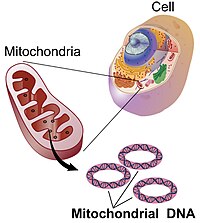
Photo from wikipedia
The molecular evolution of mitochondrial genes responds to changes in energy requirements and to high altitude adaptation in animals, but this has not been fully explored in invertebrates. The evolution… Click to show full abstract
The molecular evolution of mitochondrial genes responds to changes in energy requirements and to high altitude adaptation in animals, but this has not been fully explored in invertebrates. The evolution of atmospheric oxygen content from high to low necessarily affects the energy requirements of insect movement. We examined 13 mitochondrial protein-coding genes (PCGs) of grasshoppers to test whether the adaptive evolution of genes involved in energy metabolism occurs in changes in atmospheric oxygen content and high altitude adaptation. Our molecular evolutionary analysis of the 13 PCGs in 15 species of flying grasshoppers and 13 related flightless grasshoppers indicated that, similar to previous studies, flightless grasshoppers have experienced relaxed selection. We found evidence of significant positive selection in the genes ATP8, COX3, ND2, ND4, ND4L, ND5, and ND6 in flying lineages. This results suggested that episodic positive selection allowed the mitochondrial genes of flying grasshoppers to adapt to increased energy demands during the continuous reduction of atmospheric oxygen content. Our analysis of five grasshopper endemic to the Tibetan Plateau and 13 non-Tibetan grasshoppers indicated that, due to positive selection, more non-synonymous nucleotide substitutions accumulated in Tibetan grasshoppers than in non-Tibetan grasshoppers. We also found evidence for significant positive selection in the genes ATP6, ND2, ND3, ND4, and ND5 in Tibetan lineages. Our results thus strongly suggest that, in grasshoppers, positive selection drives mitochondrial genes to better adapt both to the energy requirements of flight and to the high altitude of the Tibetan Plateau.
Journal Title: Frontiers in Genetics
Year Published: 2018
Link to full text (if available)
Share on Social Media: Sign Up to like & get
recommendations!